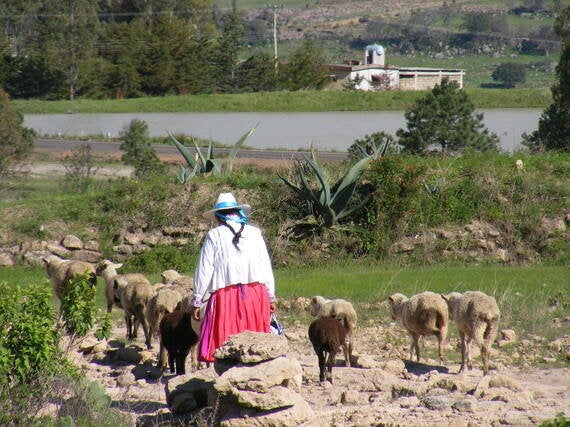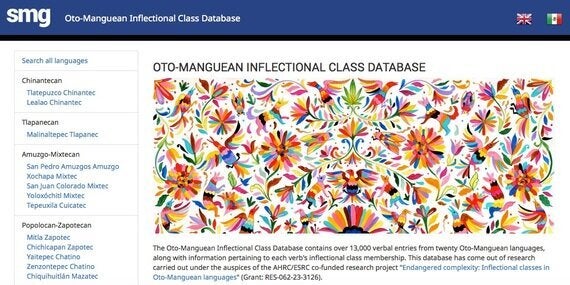Eighty percent of the world's population speak just 83 of our 7000 languages. With over fifty percent of these projected to be lost by the end of the century, indigenous communities and linguists are working together to preserve some of the world's most endangered communication systems and unravel some of their complexities while there is still time.
In my last blog post, Tim Feist and I talked about the Oto-Manguean languages of Mexico, a great number of which are considered endangered - out of nearly 200 languages which belong to this family, a staggering 73 of them (more than 1 in 3) are listed by UNESCO as endangered to one degree or another! Yet Oto-Manguean languages are some of the most complex languages on the planet in terms of how their verbs are conjugated, and once these languages become extinct we lose this valuable insight into how the human mind can handle this sort of linguistic complexity.
In the interview that follows, I will ask Tim Feist about his collaborative research on Oto-Manguean languages in order to get a better understanding of what is at stake in language loss.

In our recent blog post, you said that researchers at the University of Surrey have been investigating indigenous languages spoken in Mexico. Could you elaborate on this?
Yes, that's right. We have been investigating the complex systems of verbal conjugation in twenty indigenous languages spoken in Mexico (all part of the large Oto-Manguean language family) under the auspices of the ESRC and AHRC co-funded research project, 'Endangered Complexity: Inflectional classes in Oto-Manguean languages'. This research was carried out by a team based at the Surrey Morphology Group of the University of Surrey (Prof. Greville Corbett, Dr. Matthew Baerman and myself), the University of York (Prof. Dunstan Brown) and the CNRS in France (Dr. Enrique Palancar). But we have also received the invaluable help of other colleagues around the world¸ who provided both primary data and ideas as to how to analyse them
The Surrey Morphology Group is a linguistics research centre dedicated to the study of language diversity and its theoretical consequences. That's why, for this research project, we chose to focus on the Oto-Manguean language family, since languages of this family display extremely complex verbal systems, providing us with a window into just how complex languages can be. A better understanding of these languages, in turn, helps us to address the theoretical question concerning the degree to which the human mind is able to handle linguistic complexity.
Talking of complexity, you drew a comparison between three classes in Spanish and seventy classes in Tlatepuzco Chinantec. Is it the sheer number of classes that makes these languages so complex?
Well, in part, yes. But that is only one small part of the story. The most fascinating thing about the conjugation systems of many Oto-Manguean languages is the fact that verbs can belong to more than one class at the same time, and that these classes operate independently of, and cross-cut, each other. This radically increases the number of possible classes a verb might belong to. So, for example, the verbs of a given language might fall into 8 different classes based on what prefixes or suffixes they take (much like in Spanish), but they might also fall into, say, five different classes based on their tones. That gives us a logical possibility of 40 classes. And, what's worse, there is often no way of knowing which class a word belongs to just by looking at it (unlike in Spanish, where you know the class just by glancing at its ending), so speakers just have to memorise this in order to conjugate it correctly.
Well this is certainly beyond anything my brain has had to deal with in my language studies... It's interesting that in Romance languages it's the suffix (the verb ending) that determines the verbal class, whereas in Oto-Manguean languages, you are saying that it's the prefix (the affix placed at the beginning of the verb). It's also the fact that many Oto-Manguean languages are tonal languages, like many African and East Asian languages. This means, if I'm right, that whereas in English or Spanish we change the pitch to convey emphasis, express emotion, or indeed to turn an affirmative sentence into a question, these languages use tone to determine meaning.
Yes, that's right, Oto-Manguean languages may use tone to determine meaning. The role that tone plays varies from one language to another and the systems can be surprisingly different, even though the languages belong to the same family. With regards to prefixes, while Romance languages show a preference for suffixes, prefixes are pretty common in Oto-Manguean languages, although suffixes are also widely used and languages may use both prefixes and suffixes to convey different grammatical information

Can you give me an example of these prefixes and tonal patterns to help visualise this?
Of course. Take the language Tepeuxila Cuicatec, for example, spoken by about 4,000 people in the village of Santa María Pápalo in Oaxaca state. Verbs in this language fall into different classes based both on the prefixes they use to mark different tenses, as well as their tonal patterns.
Let's consider the prefixes first. (Note that the superscript numbers indicate the tone or pitch with which each syllable is pronounced). Compare the following two verbs:
'fall ill'
ka³-ta¹ - s/he will fall ill
yi³-ta¹ - s/he falls ill
chi³-ta¹ - s/he fell ill
ndi³-ta¹ - s/he has fallen ill
'find out'
ka³di²nu² - s/he will find out
yi²-ka³di²nu² - s/he finds out
ch-ka³di²nu² - s/he found out
n-ka³di²nu² - s/he has found out
These two verbs belong to distinct classes, in the same way that the Spanish verbs hablar 'speak' and beber 'drink' belong to different classes (hence we say yo hablé 'I spoke' with an 'e', but yo bebí 'I spoke' with an 'i', and not the other way around). The same thing happens in Cuicatec. In these two verbs, the prefixes are different: the verb 'fall ill' uses the prefixes ka-, yi-, chi- and ndi- to distinguish the different tenses, while the verb 'find out' doesn't take a prefix for the future tense, and for the other tenses takes the prefixes yi-, ch- and n-.
In our analysis of the Cuicatec data we identified 28 distinct classes according to the prefixes they take. But things get even more juicy when we look at the tonal patterns of these verb forms. For example, the verb 'cut oneself' takes the exact same set of prefixes as the verb 'fall ill' that we have just seen, but the tones of this verb are different (which is a good job, given that the verb root is -ta in both verbs!).
'cut oneself'
ka¹ta¹ - s/he will cut him/herself
yi²ta² - s/he cuts him/herself
chi¹ta² - s/he cut him/herself
ndi³ta³ - s/he has cut him/herself
So, for many of the languages we studied, we proposed that a verb may belong to various distinct classes at the same time. For example, in Cuicatec, a verb can belong to one class according to its prefixes (in this manner 'fall ill' and 'cut oneself' belong to the same class), but to another class on the basis of its tonal pattern (so along this parameter the two verbs belong to different classes)
When you consider the possible ways in which these two types of classes can interact, in addition to other factors that I haven't mentioned, we are left with languages which display some of the most complex conjugation systems on the planet! That makes these languages a cultural treasure of diversity.
At the risk of opening another can of worms, what are these factors that you haven't mentioned yet?
Well, in addition to prefixes and tones, some Oto-Manguean languages also display internal changes in the forms of their verbs. This is a bit like the English words foot and feet, where a change in the vowel in the middle of the word is used to express the plural. Or in a verb's conjugation we might encounter a form that doesn't seem to fit with the rest, a bit like English go and went, which are the present and past forms of the same word, but which look nothing like each other. Once you combine phenomena like these with changes in prefixes and tone, the word 'complexity' begins to sound inadequate.
You can say that again. So now we've tackled the idea of linguistic 'complexity', could we turn briefly to the notion that Oto-Manguean languages are 'endangered'?
Of course. In some cases, languages are no longer transmitted in a meaningful way to younger generations, and kids end up being monolingual Spanish speakers. Once a language dies, so does its unique grammatical system. In the case of Oto-Manguean languages, we would be losing a grammatical system which is unique in terms of its complexity, hence the name 'endangered complexity'. It's not all bad news, however, as many Oto-Manguean languages are spoken by thousands of speakers in vibrant communities.

Do you think that your research can help to preserve these languages?
Yes, we hope so. A big contributing factor to language death is when speakers perceive their own language as worthless and start shifting to the dominant language of society. Often, when speakers learn that researchers from the other side of the world are interested in their language, this encourages them to appreciate its unique value. As part of our research project, we created an open-access, online database, making all our data and analyses freely available. We hope that this resource will be used not only by linguists, but also be native speakers of these languages, allowing them to explore just how fascinatingly complex their languages are.
For some languages, however, the outlook is rather bleak. This is the case of Tilapa Otomi - one of the twenty languages in our database - which has only a dozen elderly speakers remaining. For this language, our research and our analysis of the data will remain as a record for future generations of researchers.
Thanks, Tim. This database seems to me to be an incredibly valuable and rich resource, both for local communities fighting to preserve their linguistic heritage and for language aficionados and researchers wanting to further their understanding of world languages. I hope the SMG's research will serve as inspiration to other researchers and language specialists to undertake work on endangered languages before it is too late - research that can not only play a part in preserving certain fascinating languages from extinction, but also in reviving interest in, and appreciation for, minority languages in different communities across the world.
Image attributions:
1) A speaker of Querétaro Otomi, tending to her sheep in the village of El Bothe.
2) Dr. Enrique Palancar (CNRS) conducting fieldwork with Doña Petra, one of the remaining few elderly speakers of Tilapa Otomi.
3) The home page of the Surrey Morphology Group's Oto-Manguean inflectional class database.
